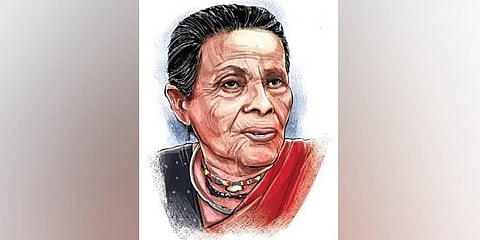

KOCHI: Mercy means ‘Daya’ in Malayalam. For Mercy Mathew, born into a landed Christian family in the rubber belt of Pala in Kerala in 1940, her journey to Daya Bai, as she’s now known, however, was not as simple. Having devoted over six decades of her life working and living among Gondi tribals in Madhya Pradesh’s Chhindwara district, 82-year-old Bai had been at the forefront for several causes over the years serving the refugees during the Bangladesh war, and the umpteen struggles for the upliftment of the tribals she led in different parts of the country.
Bai, however, had rarely taken up any causes in her home state. She had taken a vow not to return to her home (and home state) when she set off to become a nun at the age of 16 in a convent at Hazaribag, Jharkhand (then Bihar), before finding her calling among tribals of Madhya Pradesh. When her father died, her family waited for five days with the body for his darling daughter to have one final goodbye. But Bai did not turn up.
But she led a solo indefinite hunger strike outside the state secretariat in Thiruvananthapuram demanding better healthcare facilities for the endosulfan victims of Kasaragod, Kerala’s northernmost district, nearly 600 km from the state capital. Her strike for endosulfan victims began aptly on Gandhi Jayanthi day and it lasted for 17 days. Bai, who looks every inch a tribal woman (she even changed her attire to look like a tribal some 42 years back), ended her strike last week sipping the water offered by two women ministers of the Pinarayi Vijayan cabinet. This followed a written assurance by the Left government that better treatment and care would be provided for the endosulfan pesticide victims of Kasaragod.
“I’ll be forced to re-launch my agitation if the government fails to implement the assurances they gave me. Each of their assurances have a fixed time frame for implementation as per the written assurance,” Bai told this newspaper.
Endosulfan tragedy related to the spraying of the insecticide endosulfan a highly potent neurotoxin that was later banned in 2011 in more than 20-gram panchayats in Kasaragod by public sector Plantation Corporation of Kerala between 1975 and 2000, killing more than 1,000 people. It is estimated that it has poisoned another 6,000 people. Thousands of children were born with congenital disabilities, diseases of the nervous system, epilepsy, cerebral palsy, and other severe physical and mental disabilities. “I started associating with endosulfan victims in 2018 when I visited their homes in Kasaragod that year. Children are still born with severe genetic and physical deformities,” said Bai.
During her 17-day hunger strike, Bai was forcibly hospitalised on a number of occasions, but she returned to the protest site after discharge on each occasion. Her demands included better facilities for patients, daycare centres, specialised centre for scientific research to assess the mental and physical condition of victims and financial help for victims. The state government pleaded its helplessness on her demand to locate the upcoming AIIMS in the state be set up in Kasaragod as the land for the hospital was already acquired in Kozhikode.
For Bai, the end of her protest is perhaps the beginning of something new in Kerala. “Right now, I’m planning to rush back to Chhindwara, where my people are waiting. Diwali is a big festival there, and the celebration among the tribal community is very special,” she said. But Bai said her next innings will be in Kasaragod, where she’s going to be with the endosulfan victims and their families. “I have some commitments to finish, and after that, I’ll be in Kasaragod,” she winds up. Her fight never ends.